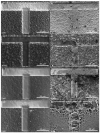The Effect of Surface Treatment on Structural Properties of CVD Diamond Layers with Different Grain Sizes Studied by Raman Spectroscopy
- PMID: 33800508
- PMCID: PMC7962972
- DOI: 10.3390/ma14051301
The Effect of Surface Treatment on Structural Properties of CVD Diamond Layers with Different Grain Sizes Studied by Raman Spectroscopy
Abstract
Extensive Raman spectroscopy studies combined with scanning electron microscopy (SEM) and X-ray photoelectron spectroscopy (XPS) measurements were performed to investigate structural and chemical changes in diamond layers deposited by chemical vapour deposition (CVD) upon post-growth treatment with hydrogen. The aim of this study is to characterize the changes in micro-structural properties of diamond layers with different grain sizes and different contents of sp2 carbon phase. Hydrogenation or oxidization of diamond layer surface is often performed to modify its properties; however, it can also strongly affect the surface structure. In this study, the impact of hydrogenation on the structure of diamond layer surface and its chemical composition is investigated. Owing to their polycrystalline nature, the structural properties of CVD diamond layers can strongly differ within the same layer. Therefore, in this project, in order to compare the results before and after hydrogen treatment, the diamond layers are subjected to Raman spectroscopy studies in the vicinity of a T-shape marker fabricated on the surface of each diamond layer studied.
Keywords: CA; Raman spectroscopy; SEM; XPS; diamond CVD; hydrogen treatment.
Conflict of interest statement
The authors declare no conflict of interest.
Figures












References
-
- Pei X., Cheng S., Ma Y., Wu D., Liu J., Wang Q., Yang Y., Li H. Structure and wettability property of the growth and nucleation surfaces of thermally treated freestanding CVD diamond films. Appl. Surf. Sci. 2015;346:189–193. doi: 10.1016/j.apsusc.2015.03.172. - DOI
-
- Kaibara Y., Sugata K., Tachiki M., Umezawa H., Kawarada H. Control wettability of the hydrogen-terminated diamond surface and the oxidized diamond surface using an atomic force microscope. Diam. Relat. Mater. 2003;12:560–564. doi: 10.1016/S0925-9635(02)00373-4. - DOI
-
- Landstrass M.I., Ravi K.V. Resistivity of chemical vapor deposited diamond films. Appl. Phys. Lett. 1989;55:975–977. doi: 10.1063/1.101694. - DOI
-
- Sato H., Kasu M. Electronic properties of H-terminated diamond during NO2 and O3 adsorption and desorption. Diam. Relat. Mater. 2012;24:99–103. doi: 10.1016/j.diamond.2011.12.004. - DOI
-
- Kubovic M., Kasu M., Kageshima H., Maeda F. Electronic and surface properties of H-terminated diamond surface affected by NO2 gas. Diam. Relat. Mater. 2010;19:889–893. doi: 10.1016/j.diamond.2010.02.021. - DOI
Grants and funding
LinkOut - more resources
Full Text Sources
Other Literature Sources

